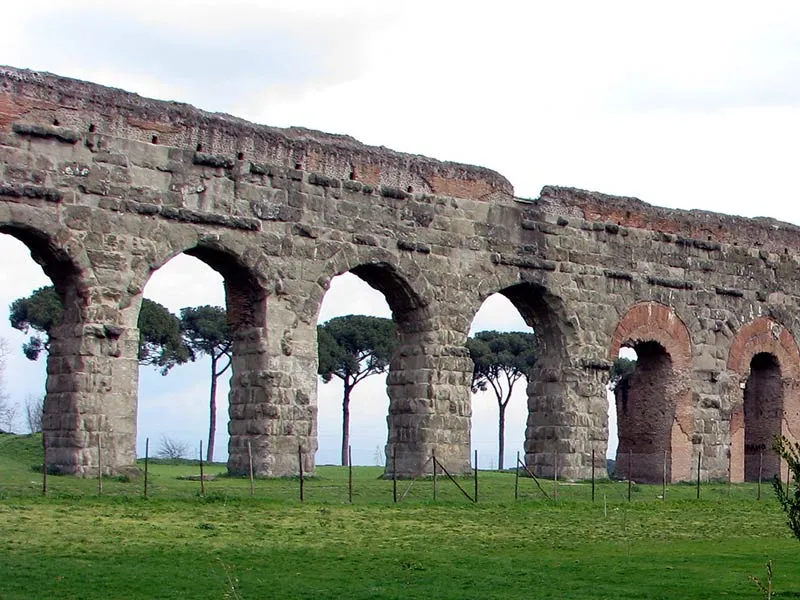
The theme of water in the Roman world commonly evokes the spectacular aqueducts that brought water to Rome and other major cities throughout the empire. The aqueducts were certainly an important component of Roman civilization—they provided water for the baths that were an essential feature of life in Roman cities, and they also raised standards of living. But perhaps a lesser-known story about water in the Roman world concerns its use in agriculture, drawing connections to contemporary issues of privatizing natural resources. In the dry conditions that characterize much of the Mediterranean world, access to water for irrigation was crucial for individual farmers and for agrarian communities. Irrigation raised the production of the rural economy, helping produce the food needed to maintain the urban culture served by the aqueducts.
The crucial issue that communities in the Roman Empire confronted was one that any society dependent on irrigation faces: how to share water as a “common pool resource” in an equitable way that meets the needs of individual users while preserving it for the future. Common pool resources include not just water, but also woodlands, pasturelands, fisheries, and today, bandwidth. They are not anyone’s private property but their use by one person subtracts from what is available to everyone else. The Nobel Laureate Elinor Ostrom of Indiana University devoted her life’s work to analyzing how societies avoid the “tragedy of the commons,” a race to the bottom in which everyone has an incentive to use as much of the common resource as possible without any regard for others or for the future. Not surprisingly, many of the solutions Ostrom saw as successful in the later societies that she studied were adapted early on by the Romans.
One of these solutions was to turn rights to water into private property. The Romans did this in the Republican period (509 BCE - 27 BCE) by creating a predial or rustic servitude for water. A servitude represents a right that an owner of a “dominant” property would exercise over a resource associated with a “servient” property, i.e., a property with a valuable resource that the owner of a “dominant” property would need to use. Such servitudes could involve many aspects of rural life, such as rights of way or the right to pasture animals, as well as the right to draw water. The servitude for water was a right strongly protected in Roman law since it was attached to the land in question rather than the person who owned it or cultivated it. As land changed hands over time, the new owners would acquire the same rights and obligations as the previous owners.
Cynthia Bannon, an ancient historian also from Indiana University, sees the servitude for water as a legal codification of traditional reciprocity among neighbors who were willing to share water resources such as springs and streams that were scattered across the countryside in early Roman Italy. In the Roman imperial period, the servitude provided people with a way to gain greater certainty about their access to water, since they would not need to undertake costly negotiations as they searched for water every year. Turning access to water into a private property right represented an important incentive for investment, and helped Roman property owners produce cash crops such as wine and olive oil for Rome and the other cities in Italy.

Sharing water could be much more complicated when the water was supplied not by numerous sources but from one source, such as a river or spring. As it turns out, an inscription from Lamasba, a town in a remote area of the Roman province of Numidia (in modern Algeria), documents how one community tackled this problem. The inscription from Lamasba dates from the early third century CE, and it records the community’s solution to long-simmering disputes over rights to water from the town’s spring, the Aqua Claudiana. Lamasba was located in a semi-arid region where agriculture involved the cultivation of olive trees and other fruit trees, with grain cultivated between the trees in a form of Mediterranean polyculture. The Lamasba scheme allocated water from the Aqua Claudiana to individual landowners on a time schedule. As Princeton historian Brent Shaw demonstrates, the amount of time that a user could draw water was measured in accordance with the number of trees that person had under cultivation. In using a time schedule, the people in Lamasba were applying a method for allocating water recognized in Roman law. This solution protected smaller cultivators against their wealthier neighbors, since there was always the danger, especially in times of extreme drought, that the economically disadvantaged might be pressured into bargaining away their water rights. The Lamasba inscription shows how people in the provinces of the empire adapted Roman legal norms to provide solutions to their most pressing communal problems.
The inscription from Lamasba exemplifies the important lesson of a community coming together to reach an equitable solution for sharing a scarce but vital resource that protected smaller property owners. The community’s ability to accomplish this was linked to the authority of Roman legal institutions—the inscribing of the schedule in stone would help to defend it against any future challenges. Lamasba suggests the importance of local solutions that are embedded in a society’s broader legal policies.

